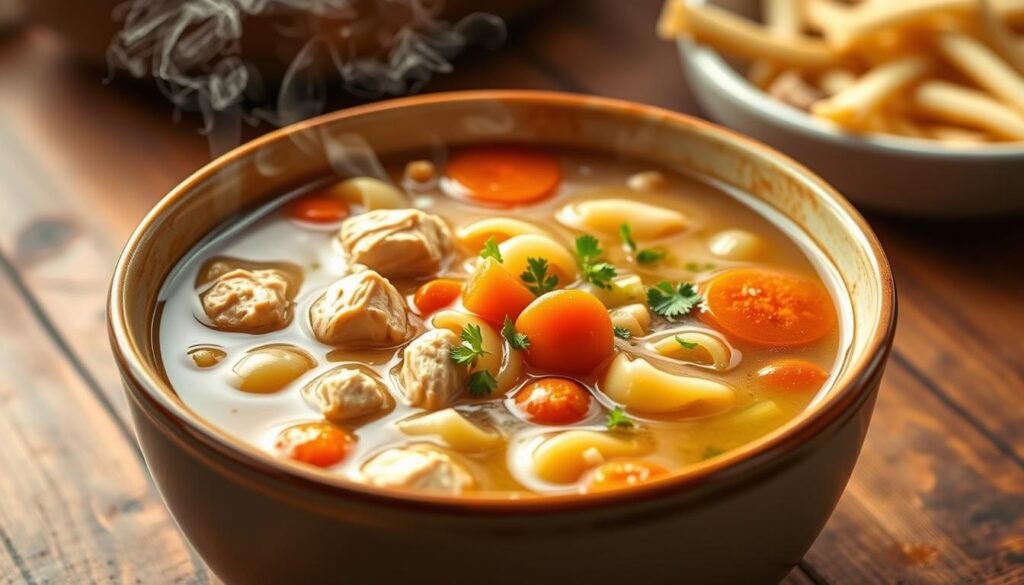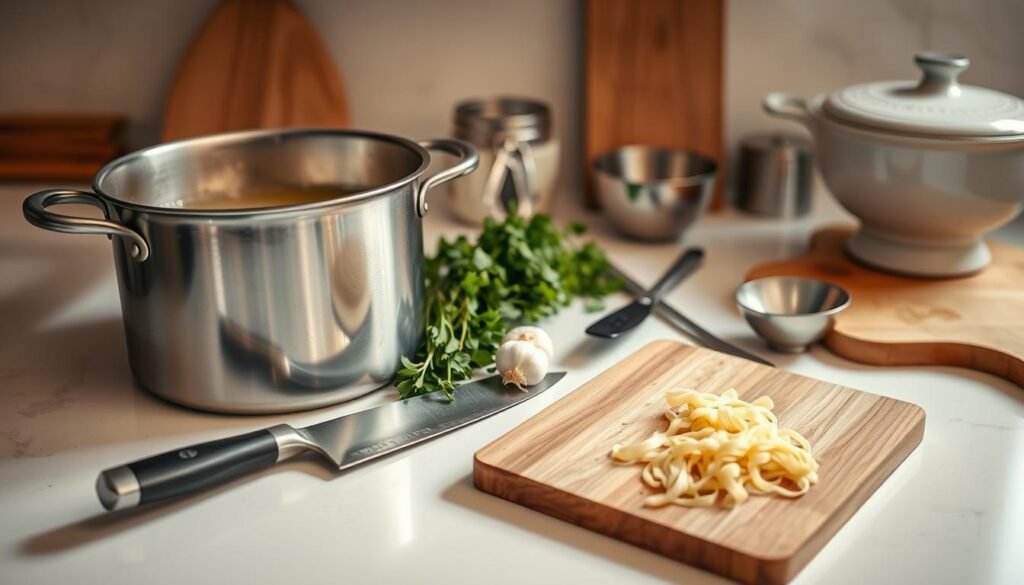There’s something undeniably comforting about a warm bowl of chicken noodle soup. This timeless comfort food has been a staple in many households for generations. It provides solace and relief during times of illness or stress.
The classic chicken noodle soup is more than just a meal; it’s a remedy that has been passed down through the years. Its healing properties and simplicity make it a favorite among both children and adults.
Key Takeaways
- A classic comfort food that provides relief during illness or stress.
- Simple to make and passed down through generations.
- Offers healing properties that make it a household staple.
- Can be customized with various ingredients to suit taste.
- A nutritious meal option that’s easy on the palate.
The History and Health Benefits of Chicken Noodle Soup
Chicken noodle soup has been a favorite for centuries. It’s not just a meal but also a remedy for many illnesses. This dish has a long history, crossing continents and cultures.
Origins of This Beloved Comfort Food
The story of chicken noodle soup starts in ancient China with “wonton soup.” As people traded and moved, this soup spread worldwide. In the US, it became a comfort food in the 20th century, bringing warmth and comfort.

Chicken noodle soup’s journey shows its flexibility and appeal. It’s a warm, nourishing meal loved by many.
Scientifically-Backed Health Benefits
Chicken noodle soup is more than comfort food; it’s good for you too. The steam helps ease congestion, and chicken gives your body protein. Carrots and celery add important vitamins and minerals.
Studies suggest it may fight inflammation, helping with cold or flu symptoms. The mix of ingredients in this soup boosts its healing power. That’s why it’s a top choice when you’re not feeling well.
Essential Ingredients for the Perfect Chicken Noodle Soup Recipe
A great chicken noodle soup starts with top-notch ingredients. To make a delicious and comforting soup, knowing each ingredient’s role is key.
Selecting the Right Chicken
Choosing the right chicken is vital. Go for boneless, skinless chicken breast or thighs for the best taste and texture. Breast meat is lean, while thighs are juicier and more flavorful. Mixing both can balance the soup nicely.
Choosing the Best Noodles
The noodles you pick can change the soup’s character. Traditional egg noodles are a favorite, but try rice or quinoa noodles for something new. Pick high-quality noodles and cook them until they’re just right to avoid mushiness.

Fresh Vegetables and Aromatics
Fresh veggies and aromatics are essential for a rich broth. Onions, carrots, celery, and garlic are must-haves. They add flavor and nutrients. Chop them finely to release their flavors while cooking.
Herbs and Seasonings
Herbs and seasonings make the soup pop. Bay leaves, thyme, and parsley are great choices. Don’t forget salt and pepper for seasoning. A bit of paprika or cayenne can add a nice zing.
| Ingredient | Purpose | Recommended Type |
|---|---|---|
| Chicken | Protein and flavor | Boneless, skinless breast or thighs |
| Noodles | Texture and carbohydrate source | Egg noodles or rice noodles |
| Vegetables | Flavor, nutrients, and aroma | Onions, carrots, celery, garlic |
| Herbs and Seasonings | Flavor enhancement | Bay leaves, thyme, parsley, salt, pepper |
Kitchen Equipment You’ll Need
Making chicken noodle soup needs a few important tools. The right equipment makes cooking easier and the soup tastes better.
Pots and Utensils
You’ll first need a large pot. It should be deep and have a heavy bottom for even heat. A stainless steel or Dutch oven pot works best for the broth. You’ll also need a cutting board for chopping veggies and a sharp knife for clean cuts. A wooden spoon or spatula is key for stirring the soup.
Optional Tools That Make the Process Easier
While not necessary, a kitchen strainer helps with skimming the broth. An immersion blender is handy for a smoother soup. Using a timer ensures your noodles are just right.

Preparing Your Ingredients
Getting your ingredients ready is key to a great chicken noodle soup. It makes sure your soup tastes good and is safe to eat.
Vegetable Preparation Techniques
Preparing veggies for your soup is more than just chopping. You need to know the right techniques to bring out their flavors. First, wash your veggies well to get rid of dirt and pesticides.
Peel veggies like carrots and onions. Their skins can be tough and fibrous. Then, chop them into uniform pieces for even cooking.
For example, slice carrots into thin coins or chop celery into small, uniform pieces. This way, all veggies cook evenly, so none are mushy and others are crunchy.
- Onions: Chop or slice them as you like, but keep them evenly sized.
- Carrots: Peel and slice or julienne them for quicker cooking.
- Celery: Chop into small, uniform pieces to release their flavor.

Chicken Preparation Tips
Preparing chicken for your soup is just as important as veggies. Start by rinsing the chicken under cold water, then pat it dry with paper towels. This removes excess moisture, helping the chicken cook better.
When cutting the chicken, you have choices. You can leave it whole or cut it into bite-sized pieces. Cutting into smaller pieces helps the chicken cook evenly and quickly.
- Whole Chicken: Use a whole chicken for a richer broth, then shred or chop the cooked chicken.
- Chicken Pieces: Cut into bite-sized pieces for quicker cooking and easier eating.
Step-by-Step Soup Recipe: Making the Perfect Broth
Making a rich broth is easy when you break it down. The broth is key to a great chicken noodle soup. It needs attention and patience. We’ll show you how to make a flavorful base and master simmering.
Creating a Flavorful Base
The base of your broth is very important. Start by sautéing onions, carrots, and celery in oil. This brings out their sweetness. Next, add chicken, like wings and backs, for depth.
Pour in cold water to cover everything. Add a pinch of salt to enhance flavors.
Key ingredients for a flavorful base include:
- Aromatic vegetables (onions, carrots, celery)
- Chicken parts (wings, backs, or a whole chicken)
- Cold water
- Salt
“A good broth is all about balance and patience,” say culinary experts. The slow cooking process allows the flavors to meld together beautifully.
Simmering Times and Techniques
Simmering is where the magic happens. It’s important to simmer gently, not boil. This prevents cloudiness. Simmer for at least 6 hours for the best flavor.
Tips for simmering:
- Keep the broth at a gentle simmer.
- Skim off any impurities that rise to the surface.
- Adjust seasoning as needed.
“The art of simmering is about patience and observation,” say many chefs. By following these steps, you’ll get a rich broth perfect for your chicken noodle soup.
Adding and Cooking the Noodles Perfectly
Learning how to cook noodles right is important for a great chicken noodle soup. When to add noodles to the soup is key. It affects their texture and the soup’s quality.
Timing Is Everything
The right time to add noodles depends on the noodle type. Usually, add them near the end of cooking. For most, this is 8-10 minutes before finishing.
But, some noodles like egg noodles cook faster than others. So, watch the cooking time closely.
Preventing Mushy Noodles
To avoid mushy noodles, keep an eye on their cooking time. Overcooking makes them unpleasant. Check them often and take them out when they’re just right.
Also, don’t overcrowd the pot. This helps noodles cook evenly.
7 Common Mistakes to Avoid When Making Chicken Noodle Soup
Chicken noodle soup is a favorite for many. But, it can go wrong if you make a few common mistakes. Knowing these pitfalls helps make sure your soup is always tasty and satisfying.
1. Overcooking the Chicken
Overcooking makes chicken dry and tough. Cook it just until it’s done. Then, take it out of the pot to stop it from getting overcooked.
2. Underseasoning the Broth
A bland broth can spoil the whole soup. Season the broth well with salt, pepper, and herbs. This brings out the flavors.
3. Adding Noodles Too Early
Noodles get mushy if added too soon. Add them towards the end of cooking to keep their texture.
4. Using the Wrong Cut of Chicken
The wrong chicken cut can mess up the soup’s taste and texture. Choose bone-in, skin-on chicken for a richer broth.
5. Skipping the Skimming Process
Not skimming can make the broth cloudy and greasy. Remove excess fat and impurities for a clearer soup.
6. Not Using Enough Aromatics
Aromatics like onions, carrots, and celery are key for flavor. Add enough to give your soup depth.
7. Rushing the Cooking Process
Rushing cooking can lead to undercooked ingredients and weak flavor. Let the soup simmer long enough for flavors to blend and ingredients to cook well.
Avoiding these mistakes helps make a delicious chicken noodle soup. It will become a favorite in your kitchen.
5 Delicious Variations of Classic Chicken Noodle Soup
Chicken noodle soup is super versatile. You can make it spicy, healthy, or just plain tasty. These variations are great for anyone looking to mix things up.
1. Asian-Inspired Chicken Noodle Soup
Try adding soy sauce, ginger, and rice noodles for an Asian twist. Sliced mushrooms and bok choy add flavor and nutrients. It’s perfect for those who love ginger and soy.
2. Creamy Chicken Noodle Soup
Make it creamy by adding heavy cream or coconut cream. A sprinkle of parsley or thyme adds freshness. It’s great for a cozy, indulgent meal.
3. Lemon and Herb Chicken Noodle Soup
Use fresh lemon juice and herbs like parsley and dill. The lemon gives it a refreshing taste. It’s perfect for a boost or when you’re feeling down.
4. Spicy Southwest Chicken Noodle Soup
Spice it up with jalapeños or cayenne pepper. Add black beans, corn, and diced tomatoes for a Southwestern touch. It’s ideal for spice lovers.
5. Gluten-Free and Low-Carb Options
For gluten-free, use gluten-free noodles. For low-carb, try zucchini noodles or shirataki noodles. These changes make the soup work for everyone’s diet.
Trying these variations keeps chicken noodle soup exciting. It’s a comforting dish that everyone can enjoy, no matter their diet.
Storage, Freezing, and Reheating Tips
To enjoy your chicken noodle soup over time, it’s key to follow proper storage, freezing, and reheating techniques. This keeps the soup safe to eat and preserves its flavor and nutrients.
Proper Storage Containers and Methods
Store your chicken noodle soup in airtight containers to avoid contamination and spoilage. Glass containers with tight-fitting lids are best because they’re non-reactive and easy to clean. Refrigerate the soup within two hours of cooking, and eat it within 3 to 4 days.
Freezing Your Soup for Later
For longer storage, freeze your chicken noodle soup. Use freezer-safe containers or bags, removing as much air as possible before sealing to prevent freezer burn. Label the containers with the date and contents. Frozen soup can be stored for up to 3 months.
Best Practices for Reheating Without Compromising Flavor
When reheating, do so gently to avoid overcooking the noodles or drying out the chicken. Reheat the soup over low heat, stirring occasionally, until it’s heated through. If frozen, thaw overnight in the refrigerator before reheating.
| Storage Method | Container Type | Duration |
|---|---|---|
| Refrigeration | Airtight Containers | 3-4 Days |
| Freezing | Freezer-Safe Containers/Bags | Up to 3 Months |
Conclusion: Mastering the Art of Homemade Chicken Noodle Soup
Learning to make homemade chicken noodle soup is a rewarding journey. It brings comfort and joy to all who enjoy it. By following the steps in this article, you can make a delicious and nourishing soup.
With practice and patience, you’ll get better at making it. You’ll develop your own style, making each bowl perfect. Whether it’s for a sore throat or a cozy meal, mastering this recipe is valuable.
Using the tips from this article, you’ll make an amazing homemade soup. It will become a favorite in your kitchen. So, experiment, adjust the seasoning, and perfect your recipe. Your taste buds and loved ones will thank you.
